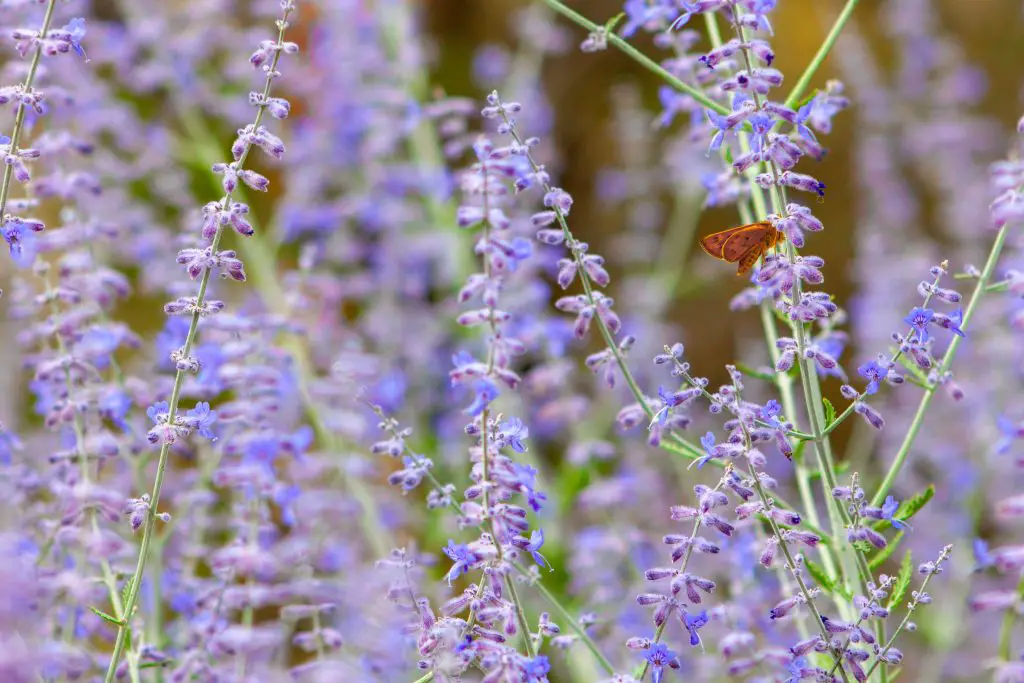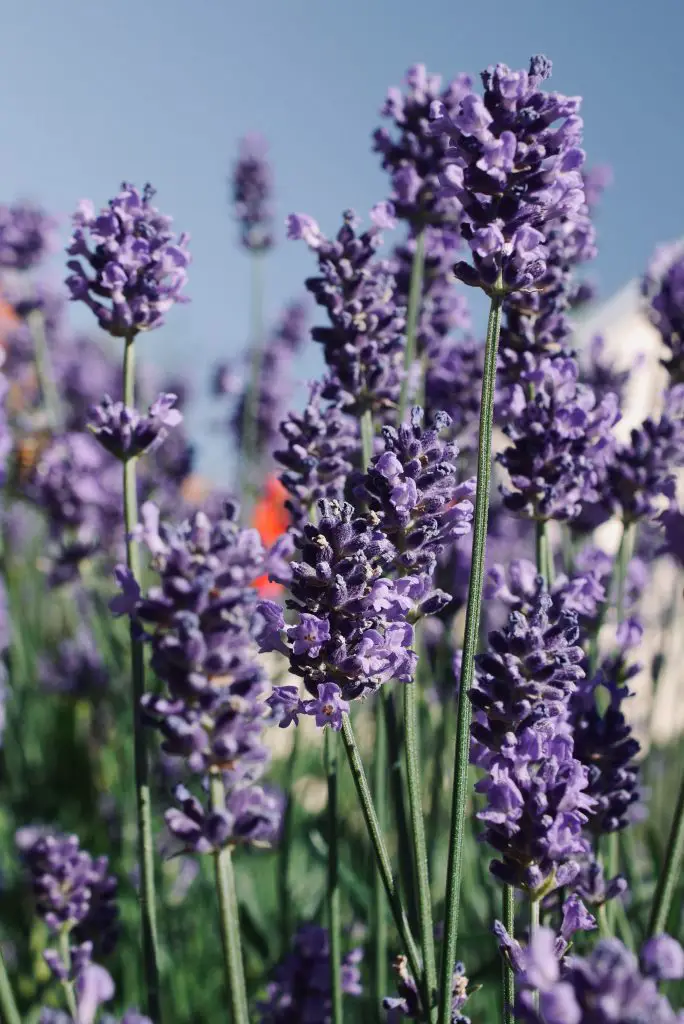How To Tell The Difference Between Lavender And Russian Sage? Lavender and Russian Sage have a similar appearance from a distance. Both have grey silvery foliage and purple flowers. So are they the same species? If not how do you tell the difference?
Lavender and Russian Sage are separate species that come from different Genus. The easiest way to tell the difference between them is to examine the flowers. Russian Sage has a tubular flower that is characteristic of the saliva genus, whereas Lavender does not, see images below. Additionally, Russian Sage does not have the distinctive lavender scent associated with lavender plants.

However, due to the resemblance of Russian Sage to Lavender it can potentially be used as a substitute in cooler locations as it is more cold tolerant, performing well in Zones 4 to 9. This is because the plant is native to central asia where the temperatures can get quite cold.
Within this genus of plants there are 7 known varieties however only one species, Perovskia atriplicifolia, is sold commercially. This botanic name was recently updated in 2017 to Salvia yangii as it was reclassified as a Salvia. The plant genus was first named in 1840, Perovskia was named after the governor of the Russian province which is possibly where the common name Russian Sage comes from.

About Russian Sage
Russian Sage is a 3 to 4 feet tall perennial shrub that will flower throughout the summer, at a similar time to Lavender attracting many bees and insects. Like Lavender, it also has aromatic, gray-green leaves that have a fine texture which makes it relatively drought tolerant.
It is ideally suited for use in a cottage garden and combines well with other white and yellow flowering such as Rudbeckia and white daisies. And while there is only one species available there are several cultivars that are available which are listed below;
- ‘Blue Spire’ is one the most common forms of Russian Sage. It has deep purple flowers and reaches a height of 3 feet typically.
- ‘Little Spire’ is a small version of ‘Blue Spire’ that produces a more compact plant that only reaches about 2 feet tall.
- ‘Blue Haze’ has pale blue flowers with broader leaves.
- ‘Filigran’ has bright blue flowers that appear 2-3 foot spikes in summer.
- ‘Longin’ has stiffer stems that mean this variety is less prone to flopping over. This makes it more suitable for formal gardens than other cultivars.
How To Grow Russian Sage
Russian sage is a relatively easy plant to grow once established and it requires very little maintenance apart from the occasional prune. Russian Sage prefers a sunny location with well-drained soil with a slightly acidic pH but the soil will generally benefit from the addition of compost prior to planting to increase nutrient levels. The plant does not like wet feet and the roots will rot if it is allowed to remain in sodden soil for too long.
Russian Sage is best planted in early spring as the roots can take some time to become established and during the first season which is when the plant is most susceptible to dry conditions. However, after this initial period, the plant is quite drought tolerant.
When putting the plant in the ground place them at the same depth as they were in the pot. Water the plant thoroughly and place a layer of mulch, 2 to 4 inches thick, around the base of the plant to help retain moisture. However, when placing the mulch around the base of the plant ensure that the mulch does not come in direct contact with the trunk of the plant as that has the potential to cause collar rot.
Once the plant is in the ground, water it regularly for the first season. You will find that the plant will tend to fall over a bit and it may require staking. Once well-established there is little maintenance required as the Russian Sage rarely has any disease or insect problems.
To keep the plant looking good it is advisable to cut the old stems down to about a foot in early spring to keep the plant from getting woody. If the plant gets too woody foliage and flower quality will go down over time.
In terms of fertilization, that only needs to be done once a year, the ideal time to do this is in early spring before new growth begins to appear. A general-purpose fertilizer such as manure pallets is will do fine for this purpose.
Propagation
Additional plants can be created by either growing them from seed or propagating the plant using cuttings. The seed can be planted at most stages throughout the year but will germinate faster in warmer conditions, with the ideal temperature being between 60 to 65ºF (15 to 18ºC).
Germination of the seeds can be slow, sometimes taking up to 4 months. Once the plants become established in the seed trays it is best to transfer them into a larger pot as this allows the roots to become more established before eventually putting the plant out in the garden.
When transplanting the seedlings into the garden be careful not to damage the roots as this will slow the progress of the plant.
To propagate the plants using cuttings it is easiest to use softwood cuttings which can be taken in the later part of spring or early summer. When taking a softwood the cutting it should be 3 to 4 inch long and have the bottom leaves stripped off.
When placing the cuttings in the pot use a dibber to make holes around the edge and put at least 4 to 5 cuttings around the outside of the pot. To increase your chances of the cutting striking it is advisable to use liquid rooting hormone. To read more about this click here.
The plant will take several weeks to root and the first signs of success will be the formation of new leaves. Once you see the first signs of growth it is advisable to leave it a few more weeks before repotting the individual cuttings.

About Lavender
Lavender is one of the most popular garden plants with a much wider range of species that the Russian Sage. There are a ranges of species that associated with different geographical locations such has French, English and Spanish lavender. Additionally, white and pink flower forms exist along with dwarf varieties.
The lavender plants have been grown since roman times and are grown commercial for their essential oils.
Like Russian Sage Lavender is a hardy drought tolerant plant that grows best in locations where the summers are hot and dry, and the winters are relatively cool. The plant prefers a sunny location that has rich well drained soil, but the plant will tolerate impoverished soil conditions as well. Heavy clay based soils should be avioded as lavanders do not like having wet feet additionally the soil pH should be neutral.
Lavender plants are best planted out into the garden in mid spring, just as the weather is starting to warm up. This will allow the plant’s root system to become established before the onset of the summer heat. Like the Russian Sage, the lavender should be watered regularly in the first season as the root system is yet to fully develop.
Once established lavender is fairly drought tolerant and will tolerate periods of dry, however, it is still beneficial to place mulch around the base of the plant to suppress weeds and retain moisture.
To maximize the the production of flowers it worth fertilizing the plant in early spring. To keep the plants in peak condition it is best to deadhead and prune regularly as lavender has a tendency to go woody if left too long.
When the plant goes woody that foliage can become sparse. Rejuvenating the plant at this stage can sometimes be difficult as Lavenders do not always repond well to a hard prune. Cutting below new shoots on a plant can often result in the entire branch dying off.

Propagation
New Lavender Plants can be grown from seed though most gardeners propagate lavender plants from cuttings. The process of growing the plants from seed is much the same as the Russian Sage. However, one way to avoid having to plant seeds is to pot on self seeded plants which sometime appear at the base of the parent plant.
But when the self seeded plants that are very small a great deal of care need to be taken to aviod distrubing the roots as this will effect the plants’ chance of survival.
When propagating from cuttings it is better to take hardwood or semi-hardwood cuttings late in the season as that tends to produce a high success rate than softwood cuttings. The cuttings taken, that should be 3 to 4 inches long and can be placed around the outside of the pot to maximize the heat of the soil. This will in turn accelerate the rate of growth of the cutting increasing the chances of success.
An alternative method to propagate plants is to simply place the cuttings in a glass of water then wait for the appearance of roots before replanting them individually into a pot.
